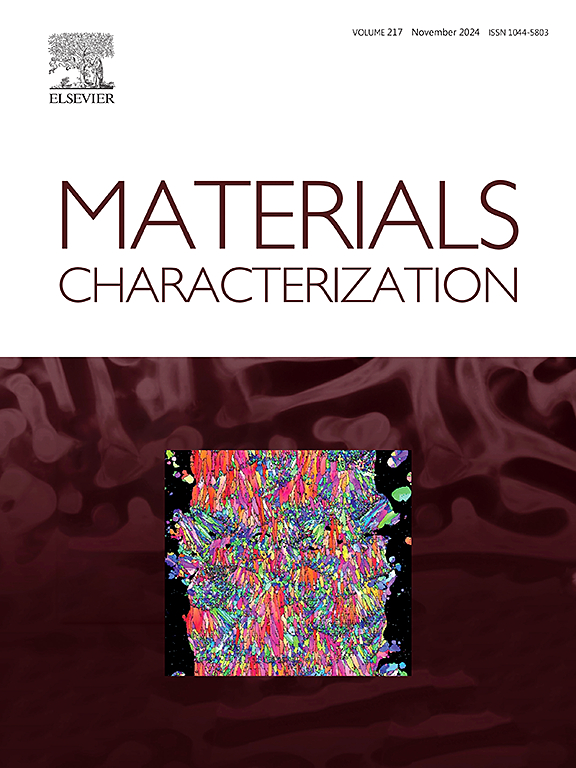Cu5Ti钎料钎焊SiC陶瓷/MA956 ODS钢接头的组织演变及抗剪强度优化
IF 4.8
2区 材料科学
Q1 MATERIALS SCIENCE, CHARACTERIZATION & TESTING
引用次数: 0
摘要
SiC陶瓷与ODS钢的连接对下一代核反应堆候选部件具有重要意义。本文采用Cu5Ti填充合金对SiC陶瓷和MA956 ODS钢进行了钎焊。研究了钎焊温度对接头组织演变和力学性能的影响,探讨了接头组织演变机理。在1060℃下钎焊10 min,接头呈现出SiC /Cu6.69Si +石墨/TiC/Ti5Si3/Cu(s,s) /TiFeSi /Ti(Fe,Cr)Si/MA956的典型界面组织。SiC表现出明显的热敏性,易与Cu发生过反应,形成过厚的陶瓷分解层,这种现象在接头断口表面广泛存在。随着钎焊温度的升高,接头的抗剪强度先升高后降低。在1060℃时,基材与填料的反应较为温和,抗剪强度最大可达42 MPa。这项工作将有助于为核反应堆结构材料的选择提供更多的选择。本文章由计算机程序翻译,如有差异,请以英文原文为准。
Microstructure evolution and shear strength optimization in SiC ceramic/MA956 ODS steel joints brazed with Cu5Ti filler
Joining of SiC ceramic and ODS steel is of great significance for the next-generation candidate component of nuclear reactors. In this work, SiC ceramic and MA956 ODS steel were brazed successfully using Cu![]() 5Ti filler alloy. The effects of brazing temperature on the microstructure evolution and mechanical properties of the joints were investigated, and the microstructure evolution mechanism was explored. The joints brazed at 1060 °C for 10 min exhibited a typical interfacial microstructure composed of SiC /Cu6.69Si + graphite/TiC/Ti5Si3/Cu(s,s) /TiFeSi /Ti(Fe,Cr)Si/MA956. SiC exhibited pronounced thermal sensitivity and easily over-reacted with Cu, resulting in an excessively thick ceramic decomposition layer, which was widely observed on the joint fracture surface. The shear strength of the joints initially increased and then decreased with rising brazing temperature. At 1060 °C, the maximum shear strength of 42 MPa was obtained due to the moderate reaction between the base materials and the filler. This work will help provide more options for the selection of nuclear reactor structural materials.
5Ti filler alloy. The effects of brazing temperature on the microstructure evolution and mechanical properties of the joints were investigated, and the microstructure evolution mechanism was explored. The joints brazed at 1060 °C for 10 min exhibited a typical interfacial microstructure composed of SiC /Cu6.69Si + graphite/TiC/Ti5Si3/Cu(s,s) /TiFeSi /Ti(Fe,Cr)Si/MA956. SiC exhibited pronounced thermal sensitivity and easily over-reacted with Cu, resulting in an excessively thick ceramic decomposition layer, which was widely observed on the joint fracture surface. The shear strength of the joints initially increased and then decreased with rising brazing temperature. At 1060 °C, the maximum shear strength of 42 MPa was obtained due to the moderate reaction between the base materials and the filler. This work will help provide more options for the selection of nuclear reactor structural materials.
求助全文
通过发布文献求助,成功后即可免费获取论文全文。
去求助
来源期刊

Materials Characterization
工程技术-材料科学:表征与测试
CiteScore
7.60
自引率
8.50%
发文量
746
审稿时长
36 days
期刊介绍:
Materials Characterization features original articles and state-of-the-art reviews on theoretical and practical aspects of the structure and behaviour of materials.
The Journal focuses on all characterization techniques, including all forms of microscopy (light, electron, acoustic, etc.,) and analysis (especially microanalysis and surface analytical techniques). Developments in both this wide range of techniques and their application to the quantification of the microstructure of materials are essential facets of the Journal.
The Journal provides the Materials Scientist/Engineer with up-to-date information on many types of materials with an underlying theme of explaining the behavior of materials using novel approaches. Materials covered by the journal include:
Metals & Alloys
Ceramics
Nanomaterials
Biomedical materials
Optical materials
Composites
Natural Materials.
 求助内容:
求助内容: 应助结果提醒方式:
应助结果提醒方式:


